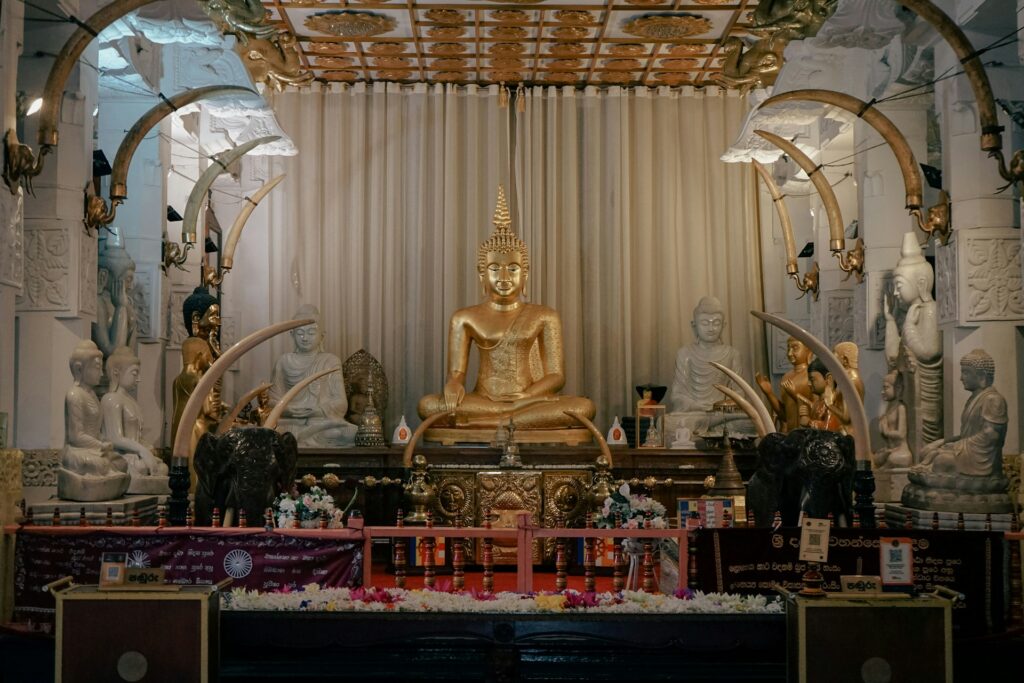15 Interesting Facts About The Temple of the Tooth
Introduction
Temple of the Tooth – Rising majestically in the mystical and history-laden landscape of Sri Lanka, Dalada Maligawa stands as one of the island’s most sacred temples. Located in the heart of Kandy city, this Temple symbolizes Sri Lanka’s religious and cultural heritage. From its construction to today, it has witnessed numerous historic events and harbored extraordinary tales within its walls. One of the Temple’s most notable features is its sacred tooth. This tooth has been a center of faith for the Sri Lankan people for millennia, strengthening their beliefs and offering visitors a mystical experience. The grand architecture and historical richness of Dalada Maligawa draw millions of people each year, holding a significant place in Sri Lanka’s religious and cultural life.
You will find 15 interesting facts about this mystical structure in this article.
1. Construction of the Temple of the Tooth:
Sri Dalada Maligawa, located in the heart of Kandy city, is an impressive structure that has witnessed many events and faced numerous challenges throughout history. The Temple suffered damage, especially during the Portuguese attacks on the Kingdom of Kandy in the 16th century. However, with the Kingdom of Kandy regaining sovereignty in the 18th century, the Temple was rebuilt and took its present magnificent form.

2.Court’s Rock (Sangili Mandapaya):
Although appearing as a simple rock platform within the temple complex, the Court’s Rock is important to Sri Lanka’s cultural and religious heritage. This platform, where traditional Sri Lankan dances and rituals are held, offers visitors the opportunity to experience the rich culture of Sri Lanka. The performances, accompanied by colorful costumes and traditional music, are a vivid example of Sri Lanka’s historical and cultural heritage.
3. Attempted Thefts at the Temple of the Tooth:
Sri Dalada Maligawa has been a target of thieves throughout history due to the sacred tooth it houses. In 1998, an attempt was made to steal the sacred tooth from the Temple, which damaged the holy relic. Fortunately, the sacred tooth was safely recovered shortly after that.
4. Queen Victoria’s Donation:
Sri Dalada Maligawa contains many donations to Sri Lanka’s religious and cultural heritage. One of these is a donation made by Queen Victoria in the 19th century when she donated a golden casket to the Temple. This casket houses the sacred tooth and is still in the temple museum. This donation demonstrates Queen Victoria’s respect for the Temple and the significance of Sri Lanka.
5. Preservation of the Temple of the Tooth:
Sri Dalada Maligawa is one of Sri Lanka’s most sacred and important temples, and the preservation of its religious and cultural heritage is of great importance. The Sri Lankan government and relevant organizations continuously strive to preserve and restore the Temple. Regular maintenance and restoration work provides visitors with a safe and magnificent environment.

6. Celebration of Poya Days:
According to Sri Lanka’s Buddhist lunar calendar, special religious ceremonies and celebrations occur at Sri Dalada Maligawa on specific full moon days. During these Poya days, the Temple became exceptionally crowded, with thousands of local and foreign visitors flocking to see the sacred tooth and worship. Silence and tranquility prevail in the Temple on these special days, with traditional Buddhist rituals being performed.
7. Temple Museum:
The Sri Dalada Maligawa complex museum offers visitors the opportunity to learn more about Sri Lanka’s rich history and culture. The museum showcases many valuable objects, such as historical artifacts, manuscripts, sculptures, and traditional costumes, which allow visitors to understand Sri Lanka’s deep cultural and religious ties.
8. Kandyan Dance Performances:
Sri Dalada Maligawa is a platform for traditional Sri Lankan Kandyan dance performances. Visitors can experience a vibrant part of Sri Lankan culture by watching these colorful and captivating dance performances. Dancers wear traditional costumes and deliver magnificent performances with drums and percussion instruments.

9. Panoramic View of the Temple of the Tooth
The location of Sri Dalada Maligawa offers a magnificent view across Kandy Lake. Visitors can admire the cityscape and the surrounding green hills from the temple courtyard. This view welcomes visitors with an impressive atmosphere and offers the opportunity to explore Sri Lanka’s natural beauty.
10. Traditional Silver Craftsmanship
The Sri Dalada Maligawa complex shops showcase beautiful examples of traditional Sri Lankan silver craftsmanship. Visitors can support local artists by purchasing handmade silver items at the temple stores. These works of art allow visitors to experience Sri Lanka’s artistic and craft heritage.
11. Daily Rituals
Every day, prayers, incense, and offerings of fragrant flowers are made to the tooth relic. The Temple’s caretakers perform these rites in compliance with antiquated customs.
12. Surrounding Temples
The Temple of the Tooth is not the only Temple within its complex. It is surrounded by several smaller temples and shrines that house revered Buddhist statues and relics.
13. The Ideal Time to Go to The Temple?
The Kandy Esala Perahera festival, which takes place in July or August, is the ideal time to visit the Temple, though it is open all year round. Traditional music, dance, and elephant processions are performed at this time while the tooth relic is towed through the streets in a magnificent procession.
14. What is the architectural style of the Temple?
The Dalada Maligawa’s architectural style was based on elements from Tang dynasty architecture. The building was also inspired by the Buddhist mandala, a symbol representing the universe in Buddhism.










